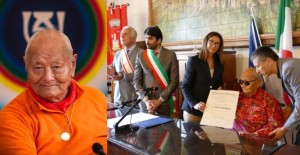
(TibetanReview.net, Sep12, 2018) – The government of Italy has on Sep 10 honoured renowned Tibetan scholar with its highest recognition, the Commander of the Order of Merit of the Italian Republic (Commendatore Ordine al Merito della Repubblica Italianam or OMRI), the highest ranking honour and most senior order of the Republic. This award exists in five degrees for “merit acquired by the nation” in the fields of literature, the arts, economy, public service, and social, philanthropic and humanitarian activities and for long and conspicuous service in civilian and military careers, with the Commander award being of the third degree.
More than 45,800 people have won the Commander degree of award since it was instituted in 1951, according to a wikipedia article on the award.
The winner, Professor Namkhai Norbu Rinpoche, was presented the honour by the Prefect of Grosseto, Cinzia Torraco, on behalf of the President of the Italian Republic, at a ceremony held in the presence of Mayor of Arcidosso Jacopo Marini and the president of the regional council of Tuscany Eugenio Giani. The venue was the Council Chamber of the City of Acridosso.

In his address, the Mayor told the gathering: “The master has dedicated his entire life to cultural research, to deepening spiritual and philosophical themes. He has always pursued the goal and the dream of peace and his presence in our territory is a great honour. This honour makes him worthy and we are proud that he was awarded this recognition by the President of the Republic”.
Also at the ceremony, former Prefect Marco Valentini, the president of the Regional council, and the Mayor of Arcidossa Jacopo Marini, along with mayors of neighbouring municipalities, presented Rinpoche with a symbolic cloth, representing the community’s recognition of the added value of Rinpoche’s presence and activities in the region.
Rinpoche was born in Derge region of Tibet’s traditional province of Kham on Dec 8, 1938 and was recognized at two lamas as the reincarnation of the Dzogchen master Adzom Drukpa. Also, at three, the 16th Gyalwang Karmapa recognized him as the mind emanation of Drug Shabdrung Rinpoche Ngawang Namgyal, the first Dharmaraja of Bhutan and an incarnation of Pema Karpo.
Rinpoche, already a scholar of great erudition in several fields of Tibetan studies at 22, was in Sikkim after a pilgrimage in Nepal and India when China annexed Tibet in 1959 and therefore could not return home. While working for the government of Sikkim, renowned Tibetologist Professor Giuseppe Tucci invited him to work at the ISMEO Institute in Rome for two years. Later in 1962 he joined the Istituto Universitario Orientale in Naples to teach Tibetan language and literature, from which he retired in 1992.
Rinpoche is known especially for his research on the ancient history of Tibet, including the country’s indigenous Bön religious tradition. His highly regarded books include works in history, medicine, astrology, Bön and folk culture.
In his later years, Rinpoche turned his attention to spreading the Dzogchen knowledge, for which purpose he established gars, or seats of the Dzogchen community, throughout the world. These currently exist in Italy, the United States, South America, Australia, and Russia.
He has also founded the International Shang-Shung Institute, which is dedicated to preserving the cultural traditions of Tibet. He has also established ASIA, a non-profit organization operating in Tibet to fuflil the educational and medical needs of the Tibetan people there.



